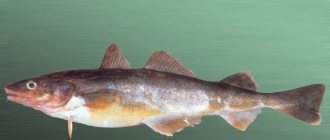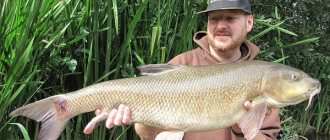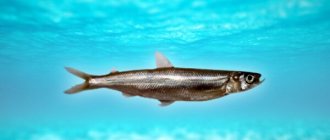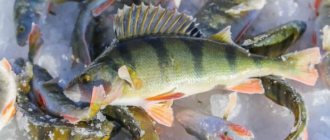Description of the omul and its way of life
Omul is a member of the genus of whitefish, primarily found in northern Asia, Europe and America. The Baikal omul lives only in Lake Baikal, entering rivers that drain into it to spawn. That is, in fact, it is endemic to the lake.
It is believed that the fish entered the lake from the Arctic Ocean during the last ice age, migrating through bodies of water that appeared after the melting of glaciers. However, it is not a subspecies of the Arctic omul, but rather a descendant of the herring or common whitefish found in the Murmansk region.
The Baikal omul is often confused with other fish of the whitefish genus. However, the closest representative of this genus, the tugun, lives approximately 300 km from the habitat of the Baikal omul, in the basin of the Podkamennaya Tunguska River, which is a tributary of the Yenisei.
Externally, the omul is a fish with an elongated body, measuring 30-60 cm in length and about 8 cm in diameter. The weight of the Baikal omul ranges from 0.3 to 1.5 kg. In rare cases, there are individuals weighing up to 7 kg. Recently, there has been not only a decline in the population, but also a decrease in the mass of its individual representatives.
It is a schooling predator, predominantly leading a pelagic lifestyle - it hunts in the water column, near the bottom of reservoirs; the main object of hunting for the Baikal omul are bottom crustaceans and other invertebrates.
Let's take a closer look at what omul eats. The main diet of omul is the epishura crustacean. This is a small crustacean, the size of which does not exceed 1.5 mm, however, the number of crustaceans swimming in Baikal water is very large. If the number of crustaceans is about 30 thousand per cubic meter. m, the fish is not looking for other food. But in the absence of epishura, it can switch to feeding on larger prey - fry and juvenile fish.
In addition, the omul has a favorite prey, upon seeing which it, as they say, “loses its will.” These include the amphipod crayfish or, in common parlance, bormash. This finds its application in winter fishing for omul. Bormash is used as bait for schools of fish.
The spawning period for omul on Lake Baikal lasts about two months. It depends on the type of fish and weather conditions. Spawning begins in September. To spawn, the fish go to the rivers flowing into Baikal. The most favorite spawning place for the Baikal omul is in areas with a rocky or sandy bottom located at a depth of no more than 2 m.
Attention! At the end of October, the annual “Omul Festival” is held on Baikal, marking the end of its spawning. Usually, after this festival, omul fishing was already allowed.
Spawning itself occurs when the temperature drops below +4°C. During spawning, the fish practically does not feed. But after it, the fish begins active feeding, hunting not only for epishura, but also for everything that it can catch. The post-spawning feast can last up to two months, since food becomes less and less available at this time.
Depending on where the omul is found, it is divided into four populations:
- Severobaikalskaya;
- Selenga;
- salting;
- Chivyrkuiskaya.
The Severobaikalsk omul goes to spawn in the Upper Angara. The remaining populations spawn in the corresponding rivers (Selenga - in Selenga and so on). Sometimes a fifth variety is also isolated - Barguzin, respectively, living in the Barguzin Nature Reserve.
The Posolsky omul, which lives in the Posolsky Sora area, is considered the largest. Its weight is approximately 20-30% higher than the average weight of omul in Baikal.
Omul is a unique brand of Lake Baikal, but not only because it is a local endemic and is of zoological interest. This fish is also a very original delicacy, very popular among gourmets.
There are many recipes in which omul is presented in a wide variety of forms:
- smoked omul (both cold and hot smoked);
- lightly salted;
- dried;
- the fish goes into the ear and guess.
Where and how to catch omul, what baits and gear are suitable for fishing
Omul belongs to the semi-anadromous whitefish. The omul is surrounded by an aura of mystery; most people believe that this fish lives only in Lake Baikal. In fact, two subspecies of this fish and several residential forms live in Russia. In addition, omul is also found in North America. The Arctic omul is considered a larger subspecies; its weight can reach 5 kg. The Baikal omul is smaller, but there are cases of catching individuals weighing about 7 kg. The Arctic omul occupies the northernmost habitat of all whitefish. Omul is considered a slow-growing species; at the age of 7 years it measures 300-400 g.
current position
Since October 2021, the Ministry of Agriculture of the Russian Federation has introduced a ban on industrial and amateur fishing of Baikal omul due to the fact that its population has decreased significantly. Indeed, currently the number of fish going to spawn has decreased by about 5 times compared to the previous decade.
If the ban had not been introduced, after about 3 years this fish would have disappeared completely. Therefore, almost all omul fishing is currently prohibited on Lake Baikal. An exception is made for two cases:
- representatives of the indigenous peoples of the north inhabiting the shores of Lake Baikal can fish in small quantities;
- Amateur fishing for omul in winter using a fishing rod is permitted.
It is planned that the ban on omul fishing on Lake Baikal will remain in effect for another 4-5 years until the fish population recovers. For now, amateurs will have to limit themselves to ice fishing.
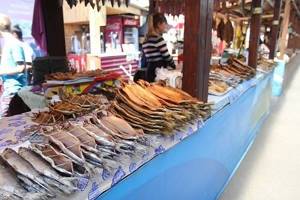
And yet, despite the ban on catching Baikal omul, even now you can not only see how much this fish costs, but also buy it in Irkutsk or even Moscow at a price of 300 to 800 rubles. per kg, depending on the type of processing.
Let's take a closer look at summer and winter omul fishing on Lake Baikal.
Fishing places and habitat
The Arctic omul not only uses areas adjacent to river mouths for feeding, but also goes far out to sea. At the same time, it can live in water with high salinity. It also feeds on crustaceans and young fish. The distribution area is between the Mezen River basin along the entire Arctic coast to the rivers of North America in Cornation Bay. The Baikal omul lives only in Lake Baikal, and spawns in the tributaries of the lake. At the same time, different herds of Baikal omul may differ in their habitats, in the lake, and in the timing of spawning.
Fishing for omul
In summer, omul can be caught both from a boat and from the shore. When fishing from the shore, you can use a float rod. The following components are suitable as bait:
- worms (both earthworms and dung);
- various plant attachments;
- special jigs - flies;
- red and yellow foam rubber.
The fishing process itself is not particularly difficult - in the summer, the fish prefers to stay near the bottom at a depth of 1-2 m and to catch it here you do not need any special skill or any specialized skills.
For fishing rods, leashes are made from 30 to 50 cm long, on which several hooks with bait are often placed. The gear setting should be such that the hooks are located no higher than 1 m from the bottom of the reservoir. Flies are one of the omul’s favorite baits, which it is partial to during any fishing at any time of the year.
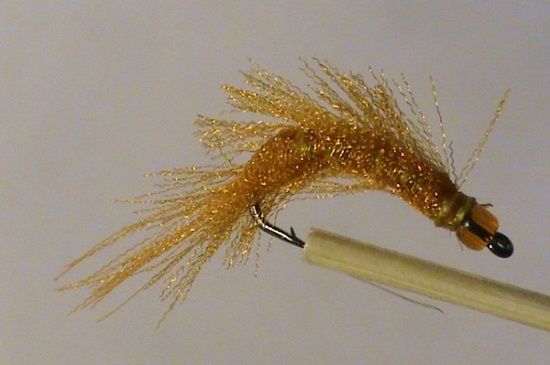
Flies can be purchased, or they can be made independently using beads and thin wire.
When fishing from a boat, spinning rods are mainly used. For this type of fishing, only bait in the form of flies is used. Often the tackle consists of several flies on one leash, or several leashes with flies.

When spinning fishing, it is recommended to use flies of different colors, so you should prepare a whole set of similar bait in advance.
If you catch omul from a boat, use gear with a special weight. The so-called sinker is used as a sinker. “ballerina” is a small piece of wire with a loop. The ballerina's weight is quite impressive - from 15 to 20 grams. The sinker is attached either in front of the leash or at the end of the fishing line, while several leashes with flies are placed in front of it.
Setup for grayling fishing
Attaching a sinker in front of the leash is used on an uneven bottom; if you use a sinker at the end of the fishing line, fishing is carried out on a flat bottom.
For the first case, one leader and one fly are used; The length of the leash is about one and a half to two meters. In the second case, up to 5 short leashes (about 5 cm long) are attached in front of the sinker at a distance of about 10 cm from one another.
In winter, omul is caught under the ice. In this case, specialized gear is used - the so-called. "tyrant" or "harvester".
Leashes with flies are attached to the main line, which has a diameter of 0.25-0.3 mm, at a distance of 5-10 cm from each other. The length of the leashes is usually chosen no more than 5 cm, their number is from 3 to 5 pieces.
Let's take a closer look at the description of the gear. Its design has several features:
- The flies should be far enough away from the main line so as not to cling to it. This is done by tying loop knots on the main line, which are pulled into a straight line by twisting with your fingers. The loop on the leash is made using a double knot. Together with the loop on the fishing line, it should form one straight line.
- The hook of the fly should always point upward. To do this, when tying the leash to the fly, it is enough to pass it through the ring on the hook from the sting side.
- Directly during fishing, you should adjust the position of the tackle so that the leashes and hooks are positioned correctly. To do this, it is enough to maintain the original position of the tackle - perpendicular to the surface of the water, so that the sinker is directly under the hole.
Important! If you use a single knot rather than a double knot on the leader, the leader and the loop on the main line will not form a straight line. This will lead to the fact that the main line and the leash will not be perpendicular to each other, but will be at an angle, which will certainly lead to twisting of the leash.
When fishing, a fishing tackle pattern called a “spiral” is used. Its essence is quite simple - the whip of the fishing rod moves in a spiral with a diameter equal to the diameter of the hole, and the pitch of the spiral is from 2 to 4 cm per revolution.
The spiral can move both clockwise and counterclockwise; both up and down. In addition, it is possible to use a “small spiral”, when with each circle its radius gradually decreases.
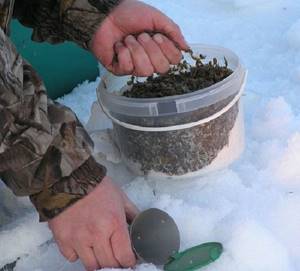
Bormash is used as bait during ice fishing. Feeders with this crustacean are placed in the place of intended fishing several days before the intended fishing.
By repeating the procedure 2-3 times, you can feed a fairly large flock of omul. According to fishermen, bites at a time close to complementary feeding time will be quite stable.
In addition, due to the good transparency of Baikal water, in winter the tactics of catching omul “by looking” are used. In this case, the fisherman lies on the ice and looks directly into the hole, watching the fish at depth. In this case, you can see both the fish and its reaction to the bait.
Baikal fishing in the freeze-up. Baikal omul.
Article categories: Omul / Baikal ice fishing / Baikal / Fisherman Elite Vladimir Pervakov, Elite Fisherman No. 6'2006, No. 1'2007, Baikal ice fishing
Baikal ice fishing is a song composed by hundreds of Irkutsk, Buryat, Krasnoyarsk, Chita and even Moscow fishermen. Listen to it too, reader! The fierce December cold covered the Siberian rivers and lakes with an ice shell. Even free waterfalls submitted to the frost and froze into amazingly beautiful crystal castles among the rocks. It seems that everything and everyone has frozen, hidden under a blanket of snow and ice.

But no. Among the white cold silence, the great Siberian sea rustles with a willful wave. Gray, gloomy, in a translucent haze. And clinging to the glass, passengers of trains rushing along the Trans-Siberian Railway look at this miracle. For a long, oh long time, Baikal gives back the warmth that it accumulated with such difficulty during the short summer. For two months there has been a struggle between the two elements. The first to freeze are litters and small bays, and in December the ice conquest of the entire Baikal begins from narrow strips of shores. The wind breaks up the first ice in waves and spreads it throughout the entire water area. Old ice is mixed with new ice! freezes, breaks open again, etc. This is how a pile of ice floes is formed - hummocks. After complete freezing, the ice on Lake Baikal in some places looks like huge sandpaper, and in others like a patchwork quilt of small ice floes. Until mid-January, the middle areas freeze, and last of all, the area above the deepest Baikal depression near Olkhon Island. The complete ice regime of Lake Baikal makes it an exception among the largest lakes in the world. For example, even Lake Ladoga, which lies much further north, freezes completely only in the harshest winters. A special lake means special fishing. The enormous depth, currents mixing layers of water, ice “breathing” through numerous cracks and steam holes provide sufficient access of oxygen to the water. Concepts such as “dead winter” and “oxygen starvation” are not applicable to Baikal, because these phenomena are absent here in principle. Therefore, fish are active here throughout the year. Ice fishing on Lake Baikal occupies a special place in the soul of the Siberian fisherman and is much more popular here than summer fishing. It is from the ice that you can use sports gear to catch plenty of omul (which has long become a “brand” of the lake) and other, no less noble fish, such as whitefish and grayling. In winter, you can reach the most hidden corners by car. Undoubtedly, in the hierarchy of ice fishing, omul fishing takes first place. No other requires so much skill and investment, does not give such pleasure and does not bring such a rich catch. People travel hundreds and thousands of kilometers for omul, and local residents may not leave the ice for months at all, only exchanging fish for food. The difficulty of fishing is that omul is a schooling fish that lives at great depths, from 10 to 200 m, and constantly moves not only in the horizontal, but also in the vertical direction. It seems incomprehensible to a beginner how one can find and even catch this coveted fish in the vast expanses of Lake Baikal. Learning to catch omul alone is a useless task. An experienced mentor is definitely needed here, and I hope this article will help many guests of Baikal who come here regularly, but have never seen the omul approach. Preparation Fishing fishermen rightfully consider themselves an elite cohort of fishermen. As a rule, people go fishing in a group of 3-5 people. Such a team is formed over the years, isolating people who are not ready for the harsh conditions of winter Baikal and large financial expenses. Preparation for fishing begins long before departure. The first necessary attribute of ice fishing is shelter from the cold and wind. It can be either a collapsible panel house, or a car booth, or a frame tent with a plywood floor, or an ordinary canvas canopy draped over poles - it all depends on your financial capabilities and desire for comfort. The most widespread are homemade tents assembled on a frame made of aluminum three sides. A human-height 2x3 m tent can comfortably fit 4 people. In a plywood floor, preferably insulated with foam plastic, holes for holes are cut in the corners. The frame itself is tied with rope for rigidity. The second attribute of omul fishing is installed in tents and houses - a “potbelly stove”. The result is a living space that will be your home for more than one day among the ice. Having frozen out on the “street”, during the period of no bite you dive, numb, into the tent - and the warmth brings you back to life, melts away pessimistic thoughts. Often, propane burners or kerosene “miracle stoves” are used instead of a stove. They are convenient because they are easy to light, and they quickly warm up the air in the tent, whereas the tent takes a long time to heat. However, no petroleum products will provide such living heat as wood logs. An apartment is not considered comfortable if there is no light in it. To solve this problem, some connect a portable lamp to the car, others use a separate battery, and recently electric generators have become increasingly popular. Thus, you have to take a whole house with you for omul fishing, but you still need somewhere to fit several bags of firewood and coal (or a gas cylinder and a burner), food, a table and chairs, cots and sleeping bags, dishes, fishing accessories, etc. a lot more. Nevertheless, with skillful fishing hands, all this fits into the interior of a minibus, a UAZ “booth” or a trailer, and the car, sitting heavily on the shock absorbers, finally sets off. With the onset of freeze-up, the omul goes to a depth of more than 200 m, where there is a constant temperature and enough food. At this time, it is almost impossible to catch it with sports gear. The abode of omul hunters at this time is the Chivyrkuisky Bay, where the local population of omul, the kuchelga, lives. In April, with the onset of warmth, omul schools rise from the depths to the shallow waters of large bays and bays, and the geography of omul fishing expands significantly. In addition to Chivir-kuy, omul “Kamchatka” appear in the Barguzin Bay, in the bays of Talanka and Oymur, and in the Maloye More Strait. “Kamchatka” is a permanent feeding place where several groups of fishermen gather, a kind of small fishing town. It is noteworthy that different places have their own rules of conduct. For example, in Chivyrkuisky Bay, everyone can put up their tent wherever they want, without asking anyone for permission. Moreover, the newcomer can even be shown where it is better to stand - in the place where the tent used to be and where the bait has already been placed, or in the direction of the current, where the fish come from for bait. But in order to join the “Kamchatka”, organized in Oymur, you need to follow a certain ritual: with pickles and a bottle placed on the hood of the car, ask permission from the senior “Kamchatka”. In the Barguzin Bay, on the “Kamchatka” they catch their own, but don’t even allow strangers closer than 300 m. If you make a mistake by a meter, you start drilling - and then a heavy, friendly hand will fall on your shoulder, and its owner will explain that “we’ve been feeding our “Kamchatka” for a month, and here you want to pull our fish to you...” Before drilling holes, you need decide on the direction of the flow, in local terms (you can’t erase the words from the song) - diarrhea. It is clear that it is better to get up from the main “Kamchatka”, but not to the side. Therefore, every fishing town has the shape of an oval, stretched in the direction of the current. The length of this “oval” during fishing rush hour reaches a kilometer or more. After you have drilled a hole and set up a tent, the second phase of omul fishing begins. Feeding Among the wide field of one or another Baikal bay (for example, the area of Barguzinsky Bay is about 700 sq. km, Chivyrkuisky - 260, Small Sea - 650 sq. km) it is impossible to find constantly moving fish. Therefore, you need the fish to find you. This can be done only by organizing the correct feeding of the Kamchatka, which, in conditions of great depth and constantly changing currents, is a real art. To attach omul you will need live and boiled drill, a cooking container, masher, sand, barley or rice and, of course, a “drill” feeder.
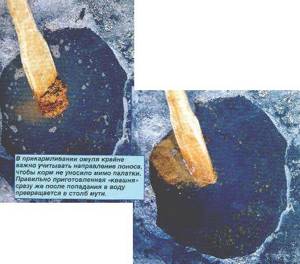
A lot of drill is required for omul fishing. On a large multi-tent Kamchatka, 15 liters will be enough for 3-4 days, but if you fish in one group, as, for example, in the Barguzin Bay, then the amount of bait will be calculated in bags. They say that before, when there was an abundance of bormash in the Baikal lakes and they fed poultry with it, they didn’t even go fishing with less than 5 pounds. In modern times, getting a lot of drill is not an easy task. To get it yourself, you have to travel hundreds of kilometers, and on the market they charge from 60 to 100 rubles for 1 liter. Getting a drill is not everything; you need to keep it alive until the end of fishing, without freezing or, conversely, “suffocating it.” Typically, large wooden boxes lined with foam or felt are used to store and transport gammarus. They are placed in the corner of the tent opposite the stove, where it is neither warm nor cold. The optimal storage temperature for drill is 0°C. The box lid is left slightly ajar to allow fresh air to enter. The crustaceans are stirred periodically so that the lower layers do not suffocate. Attachment of fish begins with pouring several liters of live and boiled drill onto the bottom - this is for omul and whitefish feeding in the bottom layers. Then the direction of diarrhea is determined. To do this, throw grains of barley or rice into the hole. In clear water you can clearly see in which direction the grain is carried away by a gentle current. Bormash is not at all much heavier than water, and even mild diarrhea immediately carries it outside your tent to your neighbors. Based on the speed of the current and the depth, drill a hole outside the tent so that the drill poured into it falls to the bottom just under your holes. The second filling of bait is done at half-water. Feeders that can quickly deliver bait to the bottom and work at a given depth come in several types. The first, a “drill,” is an ordinary tin can with holes or a tin cone, closed with a hinged lid at the bottom. The lid is weighted with a weight and is closed with a latch to which a fishing line is attached. When the “drill” reaches the bottom, it is raised to the required distance and the latch is pulled out with a sharp jerk. A less convenient, but also effective method of feeding is the so-called descent. Several lead weights are inserted into a sock or a cut-off women's stocking and a knot is tied. A fishing line is attached in the area of the knot. The sock is turned inside out, filled with drill and sent into the water. At the required depth, the lei is pulled upward - and the sock turns back out along with the bait. There is a third type of feeder - “lantern”. Make small holes in a plastic bottle, cut off the bottom and attach a lead plate along the edge. The bottle is tied to the fishing line by the neck. Having filled the container with food, it is quickly lowered into the hole so that the drill does not have time to spill out, and the bottle, carried away by the load, sinks vertically to the bottom. All that remains is to stop the fall - and the drill is already outside. Another component of the feeding process is the “kvashnya”, a spa tific invention of Baikal fishermen. The boiled tolo drill is crushed with a kush or a meat grinder to a homogeneous mass, which is then mixed with sand. The mixture is thrown in small portions with a wooden stick or scoop into the hole “upstream” from the fishing spot. Once in the water, the “butter” immediately turns into a muddy cloud, which, stretching out into a column, falls to the bottom. In the transparent Baikal water, this pillar can be seen from afar, so the “bowl” serves not so much for bait as to attract the attention of the fish. And in order for the omul to pay more attention, do not forget to throw the “bowl” as often as possible, about once every 5 minutes. The fluttering of a “moth” Tackle for winter fishing on Lake Baikal has its own name - mood. There are different moods: omul, whitefish, kharyuz, night, day, etc. When making omul, the specific fishing conditions that have already been mentioned are taken into account: depth and constant movements of the fish. The Baikal omul spirit was invented back in those ancient times, when the only fisherman’s weapon for breaking through the ice was an ice pick. Since then, the tackle, of course, has undergone some improvement, but the essence remains the same as many years ago. Main line. Its diameter must be at least 0.3 mm, the color must be transparent. Its purpose is to stretch as little as possible while playing with the mood or when hooking a fish, and not get too confused while fishing. If you use a thin fishing line, it will become extremely difficult to play with the setting at a depth of 18-20 m, since such a weight is very shock-absorbing. And thin fishing line gets tangled more often. Swivel. It should not be too large, as it may interfere with landing fish. It plays the role of an intermediary between the main line and the undergrowth. The swivel signals that there is nothing left before the fish is put into the hole, and allows you to quickly replace the leader if the mood gets confused. Undergrowth with flies. For weakly resisting omul, a fishing line of 00.18-0.2 mm is sufficient, but it must be transparent, otherwise the fish will be scared. It is the use of colored fishing line that can explain the cases when city fishermen catch a teaspoon per hour with their thin monofilament lines, and local fishermen drag one omul after another with their overly thick Klinskaya fishing line. Taking into account this requirement, fluorocarbon fishing lines have recently become increasingly popular among anglers. Sinker. It has several functions in the omul mood. It not only quickly carries the tackle to depth, but also participates in the game of flies and fishing for omul (we’ll talk about this later). The sinker must weigh at least 20 g, have an elongated “olive” shape and have two eyes. It is attached to the undergrowth by one eye, and a leash with a lower fly is mounted to the second. As a rule, at the very bottom of the omul setting, an ordinary woolen fly is placed, intended for those fish that feed at the bottom - for grayling, whitefish, sorog or perch. The leash of the lower fly is usually 20 cm long, since a longer one will get tangled in the undergrowth, and with a short one the fish will be scared of the sinker. Omul flies. They are attached to the undergrowth. The distance between them should be about a meter; accordingly, the length of the undergrowth depends on the number of flies, which are usually 5-8. Short, 4-5 cm leashes, due to the rigidity of the fishing line, do not allow flies to get caught in the undergrowth. The leashes are attached not loop to loop, but directly, using the knot shown in Fig. 1. Thus, the distance from the lower fly to the upper one is about 5-6 m, which allows you to fish a significant layer of water.
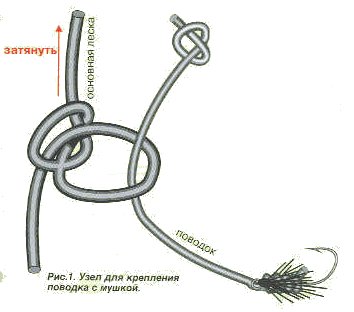
One of the main features of the omul fly is that it is crocheted on a barbless hook made from a sewing needle or spring wire (you can also file the barb on a regular hook). It is believed that the main reason for using such hooks is the ability to remove fish from the bait while wearing mittens. This is especially important in cold weather. There is no such variety of flies even in Kharyuz fishing; for the omul, the fishing imagination has worked hard. In addition to classic wool, feathers and threads, omul flies are made using multi-colored beads, wire, varnished fabric, wire insulation, synthetic bows, beer cans, etc., etc. Hence the names of the most popular flies: “bows”, “beads”, “threads”, “nets”, “cambrics”... Such a wealth of choice puzzles and confuses the beginning fisherman. Why was it necessary to create such an extensive “park” of omul flies? The fact is that omul at one time or another takes different flies of a particular type, and ignores universal natural baits such as drills. The basis for such an abundance of fly species is the variety of food that omul feeds on. Usually this is epishura - Baikal plankton. Microscopic crustaceans of various shapes and colors inhabit the entire thickness of the water. Their number can reach 35 thousand per cubic meter of water. Like a vacuum cleaner, the omul filters the water, retaining food with its gills. In addition, it feeds on gammarids and juveniles of pelagic gobies and golomyankas.
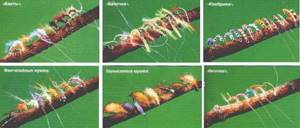
Nevertheless, any variety can be subordinated to order, a certain system can be created. But in each system, in accordance with the laws of dialectics, there are opposites. When fishing for omul, there are two different ways to determine the most catchable flies for a particular day. The first is to put a different type of fly for each set-up (and there are up to fifty of them at the mulefisher) and by using all the set-ups in a row, find the set of running flies from which one or two working settings can be made. The second is when each member of the fishing team sets the mood based on the type of fly and its shade. These can be, for example, light “bows”, dark “bows”, light “cans”, dark “cans”, etc. Option for setting in light colors: white, silver, gold, orange, light green, etc.; in dark colors: lilac, burgundy, dark green, black, copper, etc. In search of a working mood while fishing, some with one or two fishing rods begin to play with flies, changing the fishing rod and types of settings. Some time passes, and someone finds those flies that the omul is now using to determine the depth of the fish. For secrecy, some fly fishermen number their settings, where each type and color of fly corresponds to a number that is the same for all team members. For an outside angler, the phrase: “Seventeen on four” may not mean anything, while initiates rush to their boxes, look for the setting No. 17 there and lower it so that the lower fly is raised from the bottom by 4 skeins. Skein. We move on to the last component of the Baikal mood - a skein, or “moth”, as the omul fishing rod is called on Baikal. Perhaps these names are associated with the fact that she has to write intricate pirouettes in the hands of the fisherman, or with the fact that the fishing line is wound on the fishing rod, and not twisted by a reel. Industrial production of “moths” is not established; they are made by hand. “Balalaika”, “Finnish” and similar reel fishing rods are used only in exceptional cases, which we will talk about later. I know of three types of “moths”. The simplest one is Irkutsk. A reel is cut out of a pine block with a width of 25-30 mm and a tire of 350-400 mm, which is covered with foam plastic on both sides. Slots are made in the “ears” of the reel: the fishing line will be attached to them during the game with the setting, and the hooks of the flies are hidden in the foam when the setting is not active. The Irkutsk setup is convenient because it can be quickly collected from the depths, it is more durable, but due to the large leverage between the angler’s hand and the end of the reel, the hand quickly gets tired. The Maksimikhinsky “moth” is a little more complicated: it is curved like a rocker. If the fishing rod falls out of your hand, it will stop across the hole and will not allow itself to be dragged under the ice by too strong a fish. In order for the moth to stand across the hole, the slot in the reel is made deep, 5-7 cm. The classic “moth” consists of two parts: a handle and a whip. The heart-shaped handle is cut out of polystyrene foam, and there should be enough of it so that the “moth”, once in the hole, does not sink due to the heavy sinker. The whip is made from young birch branches 20-25 cm long. The branch should have 2-3 shoots, they will serve for winding fishing line. The branches are cleared of bark, excess is cut off and dried. From the slot in the handle, a longitudinal hole is made into which the whip is inserted. It is fixed with epoxy glue, and the surface of the slot is coated with the same glue. This is necessary so that the fishing line, when drying after fishing, does not cut through the fragile foam.

At the end of the whip, a thin slot is made through which the fishing line is passed. To prevent it from flying out of the slot during play, you can put a rubber ring or a large-diameter cambric on top. This “moth” fits comfortably in the hand, and the length of the winding can be adjusted using the knots on the whip. Thanks to the short lever, wiring is smooth and clear. A general view of the omul mood is shown in Fig. 2. Let me take a look at the drawing; the attentive reader will notice that something is missing. That's right, there is no semblance of a guardhouse. The omul's play in formation is unique. Anglers who are accustomed to smooth lifts, swaying or small shaking of the fishing rod have to completely adapt. Just as the omul in an unlimited water space is a free and fast fish, so the play of the flies matches it: 2-3 short swings with a “moth” and a quick upward swing of 20-30 cm. Movements, despite their speed, should not be sharp. In the hands of a skilled fisherman, the “moth” is the brush of an artist who paints ocean waves, high and sloping. The main principle of correct wiring: during the entire game, the sinker is felt under tension, that is, it is not in free fall. There is no need to jerk or suddenly lower the tackle. The omul takes the fly, as a rule, during a short pause between short fluctuations and a high rise in mood. The bite feels like stopping the tackle - no guard is needed here. If you don’t know what depth the fish is at, start from the bottom. Having made 10-15 transactions, the mood is raised higher. Then higher, and higher. The usual step is 5 skeins. You can use another, more effective technique: do not reel in the fishing line, but, while continuing to play, slowly move away from the hole. At some point the fly and the fish will meet. Previously, I thought that this was the way to find the depth of the omul, and I reconfigured the gear, however, oddly enough, no more bites happened at the found depth. And then one day in one of the issues of “Rybolov” I came across an article by an avid perch spinner. According to him, the fish, standing at a certain depth, showed interest in the bait, followed it up, but did not take it. The spoon fell down again, and everything was repeated until the fish got tired of it. However, if the bait was raised higher and higher, almost standing on the box, without interrupting the game, the perch often could not stand it and attacked the bait running away from it.
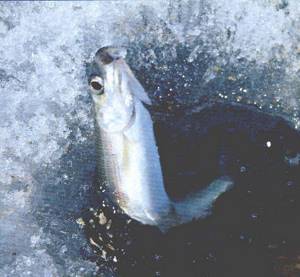
This was the idea, and on the very next fishing trip the perch technique worked “excellently” on the omul. After all, it is said: “Read and you will catch it!” Although the bite of an omul feels like a stop of the tackle, as soon as you turn the fish upward, it practically stops resisting. If the structure of the grayling skeleton is such that it can bend into a ring, then the omul is not so flexible and can only move forward. Fishermen actively use this feature to their advantage. If an omul falls into a hole, even at its very bottom, its fate is sealed. You need to swirl the water in the hole with your hand, and the fish will float to the surface on its own. Some make it even simpler: cover the hole from light with your foot. A little time passes, and a blow is felt on the leg from below. “Nippers” and “swallowtails” The main difficulty for beginner fishermen: how to pull a fish from a depth of 15-20, or even 30 m and, having unhooked it, lower the bait into the hole again, without tangling the thin fishing line? Following a habit established when fishing for grayling or sorog, the angler begins to pull out the fishing line with pincers. One meter, two, tenth... The rings of the fishing line lie on top of each other, on the hole, cling to sleeves, buttons, folds of clothing. Here the flies appear. The hooks immediately find and grab several skeins of fishing line at once. Here comes the fish. While you unhook it from the front sight, it slips out of your hands and falls onto a still even heap of coils, which after a few seconds turns into a fluffy ball. That's it, the flies can be safely cut off, there is no more omul mood. After some time, the angler realizes to throw the line in one direction from the hole, and the fish in the other. But then the loop gets caught in a loop, or the fishing line crashes into a piece of ice, or the fly gets caught in several rings of the fishing line - and again the mood turns into a lump of fishing line, and the angler into a bundle of nerves. What to do? You have to pull it out with swings. The ability to “wave” is a sign of the skill of the Baikal fisherman. But any skill must be learned, and in our case relearned, fighting the habits of “plucking”. I have never seen in the fishing press a description of how fish are pulled out of the water by swinging, but I have met a lot of fishermen on Lake Baikal (and not only) who “pluck” the fishing line, so I will take the liberty of conducting a short educational program. After all, having become a “swallowtail”, the fisherman becomes an order of magnitude more professional than he was before. The essence of “waving” is that after a bite you begin to wind the fishing line around both hands, alternately making circular movements while grabbing the fishing line. As a rule, one turn lies on the “butterfly”, and the second - above the hand, while the line between the hands forms a skein in the form of an “infinity” sign. Thus, the hands play the role of a huge reel, ensuring a uniform lifting of the tackle without slack. You need to keep your hands tucked at the same width so that not a single skein falls off and therefore becomes the reason for confusing the entire mood. Having reeled the fish out of the hole, it is pressed to the ice with your foot and the hand free from the fishing rod is released from the hook. Be careful, it is at this moment that your hands can get a little confused, sometimes the loops of the mood will inevitably fall off. Now comes an equally important stage: we need to lower our mood to depth. If the omul is caught on one of the upper flies, it will not be difficult to return the fishing line - the heavy sinker itself will remove it from your hands. The difficulty arises when the fish takes the bottom fly. Hooks, collected in a set wound around the hands, will not fail to catch on the fishing line when unwinding the tackle. What to do in this case, since both hands are busy? Usually the fly catches one or more loops, which, under the weight of the sinker, are pulled away from the main setting. You need to use short up-and-down twitches to force the flies to unhook from the fishing line (this will not work with ordinary hooks). If unsuccessful, your teeth or a nearby fisherman will help. Better yet, hold the “butterfly” between your knees, thereby freeing your hand for the necessary manipulations. What mistakes do anglers usually make when they start working with swings? Firstly, despite all the apparent convenience, you should not wrap the fishing line around your thumb. As soon as you relax your hands, all the loops will fall off. In addition, you do not have the usual freedom when freeing the fish from the bait. Secondly, you should not make too wide swings. In this case, your hands quickly get tired, and when releasing the fish, the distance between them will still have to be reduced. And the looser the line is, the more likely it is that the loops will fall off. The correct stance when playing fish with swings: arms shoulder-width apart, slightly bent, fingers slightly spread, palms facing each other.
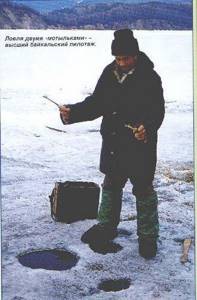
Thirdly, if the fly is wrapped with a leash around the loops when unwinding the setup, any twitching will only aggravate the situation. It is better to immediately ask someone to untangle the leash or free your hand by securing the “moth” in your knees. And two more tips: mount the “hand” flies above the rest, heavy flies (with beads, jigs) - lower. I also had the opportunity to observe masters (usually local fishermen) who, while winding fishing line on their palms, were able to free one hand by taking one of the ends of the skein into the fist of the other hand. Then the brush is inserted into the loop again, and the mood, not at all confused, goes back into the water. The aerobatics of “waving” is considered to be when a fisherman knows how to reel out the fishing line, playing with two “moths” at once. I have seen only a few Barguzin omulyatniks who master this art, but I have never figured out their secret. No matter how much I tried, but when exhausted, one mood was sure to get confused with the second. Therefore, when fishing with two “moths” at once, in case of a bite, one of them has to be thrown. By the way, one of the features of omul fishing is the ability to fish with several settings at the same time. As already noted, the omul resists weakly and, with proper “waving”, has practically no opportunity to walk in circles and catch neighboring moods. Sometimes, when there is no bite, especially avid fishermen look for luck in four moods at once. What kind of skill do you need to have so that when a fish bites, you can figure out which “moth” the fish took on, and quickly discard the other three, without tangling the fishing line! When throwing away an extra “moth”, two unpleasant things can happen: it can fall, and if it’s frosty, you’ll get back a very unpleasant icicle; a free-floating fly will be grabbed by a fish, and then the fishing rod will slip not only into the hole, but deep under the ice. Taking into account the fact that the latest trouble occurs with enviable regularity and naturally takes away the best moods, a way was invented to return the “moths” back. The first omul caught is released back, but with the lower fly attached to the dorsal fin. Anglers within a radius of the setting length are strongly advised to reel in the gear for a while, and the omul is allowed to move freely in the water. After spinning around under the hole, he usually finds the escaped mood, which, due to the light “moth”, is pressed to the lower edge of the ice. By this time, the fish, having lost the mood, is already freed from the barbless hook. The most active omul bite is at dawn. Omulyatniks say: morning fish is for everyone, afternoon fish is for the chosen few. The omul has a clear daily rhythm in its feeding activity, and during the day it is clearly low. The fish can walk in full view of the fisherman and not succumb to any provocation. If it bites, it’s hesitantly, catching itself at the very tip of the lip. You ride an omul, as if on an elevator, to the hole, and even a weak blow on the ice is enough for the hook to tear the thin skin. 4-5 meetings in a row are common. Sometimes my nerves can't handle it. Here the fisherman must, like a sniper, without allowing the omul to touch the edge of the hole, lead it exactly in the center. During the day, all hope lies in a fresh school of omul that has entered the bay from Lake Baikal. This fish is still hungry and grabs all the flies indiscriminately. A school of fish may come at 10 o’clock, at lunchtime, or it may not. Over time, the tension subsides, someone begins to prepare breakfast, someone begins to look into the hole at the mysterious depths, someone changes one mood after another in the hope of finding a successful one. But then one fisherman jumped up from the box and waved his arms. Behind him is the second, third... Approach! The entire “Kamchatka” shakes off its sleepy torpor and begins to move. Fishermen forget about breakfast and rush to the holes. After a while the excitement wears off. At the far end of the Kamchatka, individual swallowtails are still visible, and at the opposite end they are already counting the catch. Then everything freezes until the next approach. During the last ice, when the omul is increasingly located in the upper horizons of the water, almost under the very ice, you can deceive the fish in the following way. A light float rod is mounted with a main line no thicker than 00.1 mm, which not only does not alarm the fish, but also allows the hook with the drill to move in the water due to diarrhea, that is, to revive the bait. This is the very case when a fishing rod with a reel is best suited, with the help of which (and not by pinching or swinging) the omul is caught. The float, of course, is set to sliding. The day passes unnoticed. The red sun sets behind the white mountains. The wind subsides, the sounds on the ice become silent. The fishermen go to their houses and tents, “Kamchatka” is empty. Someone, having had dinner, goes to bed, but some people know that with the end of the day everything is just beginning. On the “spins” It is enough to see the omul’s disproportionately large eyes to guess that it sees perfectly in the dark. Incredible, but true: even on a moonless night, omul, being under a thick layer of ice at a depth of 15 meters, finds a small fly.
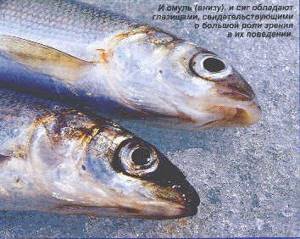
For night fishing, separate settings are installed. In the dark, omul prefers striped flies, alternating different colored cambrics and beads, but in light tones. Night fishing is different from daytime fishing - they almost don’t play with the mood. The fish’s bite on a stationary fly is unnoticeable: the omul sucks up the bait, and, sensing a catch, immediately spits it out. It's hard to see the bite, and it's even harder to catch the hook. A 20-30 cm long rail, one end of which is fixed in a stand, and the other has a needle protruding no more than 1.5 mm for safety, will help solve both problems.
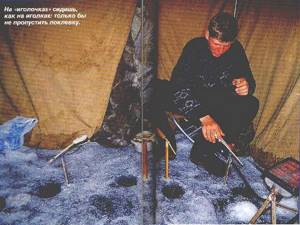
The “moth” is placed on a needle at the center of its gravity so that it can move freely in any direction. A barely noticeable movement of the fishing rod is a bite. You can hook it instantly, because “the moth is at hand level, and you don’t have to bend over. The elk requires increased attention and quick reaction. But, according to Murphy’s fishing laws, bites occur precisely at the moment when you look from the fishing rod to your partner, decide to light a cigarette, pick up a mug of tea, etc. The “moth” can be placed not only on the rail, but also on any round surface where it will be in free balance, for example, on the handle of a scoop, a masher, the leg of a chair, etc.
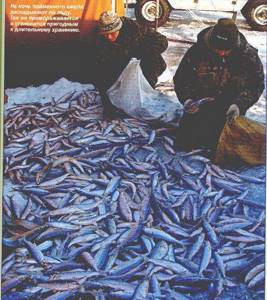
Omul actively bites 2-3 hours after dark and an hour before dawn. Great luck if you can stop a school of fish under you. Doing this at night, when the omul is not very prone to wandering, is much easier than during the day. I won’t say that fishing at night is more productive than during daylight hours. Often during the whole night you catch the same amount of fish as in half an hour of the morning meal. Baikal fishing in the freeze-up. Pike. Baikal fishing in the freeze-up. Dace. Baikal fishing in the freeze-up. Grayling. Baikal fishing in the freeze-up. Baikal whitefish Omul
Making flies
When making it yourself, omul flies are knitted on barbless hooks. They can be converted from ordinary ones by pressing the beard with pliers, or you can make them completely yourself from stiff wire or a sewing needle. The size of the hooks corresponds to No. 3 or No. 4 according to the domestic classification.
The material used to create flies is:
- beads of different colors;
- multi-colored wool;
- thin wire;
- multi-colored threads;
- varnished fabric, insulation and other non-ferrous materials.
Such a wide variety of materials is explained by the fact that the behavior of omul is quite unpredictable. Under different circumstances, it can react differently to bait, so it is necessary to have a whole arsenal of flies of different colors and shapes in stock. There have been cases when the omul even ignored its favorite prey - the drill, rushing after the fly it liked.
Currently, taking into account the catastrophic decline in the population of the Baikal omul, its fishing is permitted only in the form of ice fishing in winter. Nevertheless, it is worth visiting winter Baikal at least once in your life to enjoy the beauty of the local nature and try to catch this fish, which has become almost legendary thanks to folklore.
Diet and spawning of omul
Favorite food is planktonic crustaceans, amphipods, larvae, eggs of other fish, whitefish and perciformes, especially gobies. In sea conditions, the omul eats a lot of gammarus, mysids, large crustaceans, small cod and sculpin species: smelt, capelin, navaga, cod, and Arctic sea slingshot.
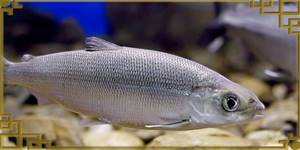
The feeding of omul stops in August-September. Sexually mature fish gather in large schools and come from the sea to the deltas of Siberian rivers to spawn. Finding a suitable spawning site can take more than a month. During this time, the fish manages to rise upstream by 1.0-1.5 thousand kilometers, while remaining cautious and preferring to stay at the maximum distance from the shore. The Baikal subspecies does not have such problems and mainly moves short distances deep into the Selenga, Angara, Kichera, and Barguzina.
Autumn spawning of omul is associated with a long incubation period of larvae (190-220 days). The main time for laying eggs (up to 65 thousand) falls at the end of September-October, when the water temperature drops to +3-4C. For this process, flowing places with a depth of two meters and sand and pebble soil are selected. The masonry is not attached to the bottom substrate, which allows the current to freely carry it to secluded places, where it slowly develops at a water temperature of +0.5-1.5C.
After the omul has completed spawning, its appetite returns, and it begins to gradually migrate from the spawning grounds to its usual feeding areas. At the same time, nothing threatens the health of the fish, and unlike many migratory salmon (sockeye salmon, chum salmon, pink salmon), it does not die after spawning.
To learn more:
What kind of fish is chum salmon?
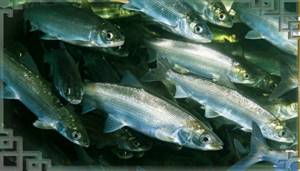
Types of omul

- Baikal omul;
- Barguzinsky;
- Malomorsky;
- ambassadorial;
- Selenga;
- Penzhinsky omul;
- Yakut omul.
The first species, as mentioned above, has 4 subspecies inhabiting Lake Baikal. The Yakut omul is a representative of the Arctic Ocean. As for the Penzhina omul, it is not much different from its Baikal counterpart, and it got its name from what is found in the Penzhina and Talovka rivers. This species of omul is listed in the Red Book and may disappear from the face of the earth forever. This is due to its uncontrolled fishing by local fishermen. It should be noted that almost all types of omul are distributed within Siberia. Therefore, we can safely say that this fish is the hallmark of Siberia.
In winter, this fish looks for a deeper place, where a constant temperature is observed throughout the winter. Indigenous fishermen set their nets very deep to catch these fish.
It is worth noting that the omul does not always go to the maximum depth and remains there without moving. It almost always migrates across a body of water. If the temperature rises, the omul comes out of its shelters and moves to shallow water areas to have a snack.
In summer , when there is no wind, it can be seen at the very surface of the water.
They catch omul all year round, except for the spawning break. The spawning period of this fish is protected by law, therefore, when the omul spawns, it is prohibited to catch it.
Omul is quite an interesting fish and it is unlikely that you will be able to catch it without certain skills. Many newcomers who decided to “hunt” for omul were left without a catch.
What kind of fish is omul
What does omul fish look like? In appearance it resembles a grayling - it has a long body, slightly flattened on the sides. Omul and grayling have one more common feature - a small mouth, the jaws of which are equal in length.
Like the grayling, the scales of the Baikal beauty resemble chain mail; they can only be removed with some effort. The king fish differs from the grayling in color - greenish, with a beautiful silvery tint. The belly is white, but the back is dark, with a brown tint. Another difference from grayling is a dark stripe along the entire body. The fins are light in color; near the tail itself there is a distinctive feature of the entire salmon family - the adipose fin.
If the life span of grayling is no more than 15 years, then omuls are long-lived - some individuals live up to two decades. Despite their life expectancy, it is impossible to meet very large representatives of the family - the average body weight is only 700-800 grams with a length of half a meter. Rarely, there are trophy specimens up to one and a half kilograms, they are found at great depths (about 250 m).
Where is this fish found? She is seduced by cold, clean reservoirs rich in oxygen. The Arctic Ocean basin and Lake Baikal are the habitat of the king fish. You can rarely find it in the lakes of Siberia; the fish living here prefer to migrate to warmer waters before spawning season.

Photo 1. Lake Baikal.


